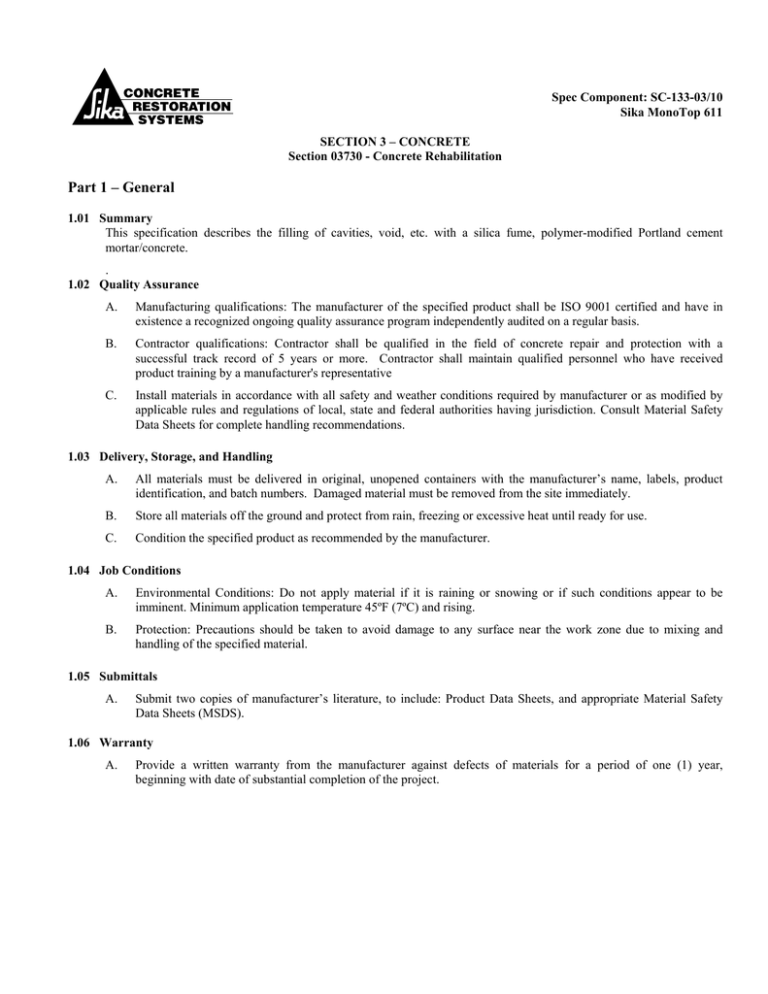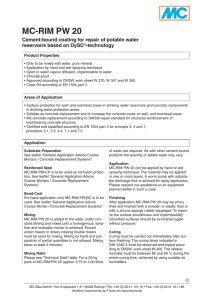Part 1 – General - Sika Corporation US
advertisement

Spec Component: SC-133-03/10 Sika MonoTop 611 SECTION 3 – CONCRETE Section 03730 - Concrete Rehabilitation Part 1 – General 1.01 Summary This specification describes the filling of cavities, void, etc. with a silica fume, polymer-modified Portland cement mortar/concrete. . 1.02 Quality Assurance A. Manufacturing qualifications: The manufacturer of the specified product shall be ISO 9001 certified and have in existence a recognized ongoing quality assurance program independently audited on a regular basis. B. Contractor qualifications: Contractor shall be qualified in the field of concrete repair and protection with a successful track record of 5 years or more. Contractor shall maintain qualified personnel who have received product training by a manufacturer's representative C. Install materials in accordance with all safety and weather conditions required by manufacturer or as modified by applicable rules and regulations of local, state and federal authorities having jurisdiction. Consult Material Safety Data Sheets for complete handling recommendations. 1.03 Delivery, Storage, and Handling A. All materials must be delivered in original, unopened containers with the manufacturer’s name, labels, product identification, and batch numbers. Damaged material must be removed from the site immediately. B. Store all materials off the ground and protect from rain, freezing or excessive heat until ready for use. C. Condition the specified product as recommended by the manufacturer. 1.04 Job Conditions A. Environmental Conditions: Do not apply material if it is raining or snowing or if such conditions appear to be imminent. Minimum application temperature 45ºF (7ºC) and rising. B. Protection: Precautions should be taken to avoid damage to any surface near the work zone due to mixing and handling of the specified material. 1.05 Submittals A. Submit two copies of manufacturer’s literature, to include: Product Data Sheets, and appropriate Material Safety Data Sheets (MSDS). 1.06 Warranty A. Provide a written warranty from the manufacturer against defects of materials for a period of one (1) year, beginning with date of substantial completion of the project. Part 2 - Scope: Product and Application 2.01 Acceptable Manufacturers A. Sika MonoTop 611, as manufactured by Sika Corporation, Lyndhurst, New Jersey, is considered to conform to the requirements of this specification and has performed satisfactorily for patching or overlaying for a minimum of three years. B. Substitutions: The use of other than the specified product will be considered providing the contractor requests its use in writing to the Engineer. This request shall be accompanied by (a) A certificate of compliance from an approved independent testing laboratory that the proposed substitute product meets or exceeds the specified performance criteria, tested in accordance with the specified test standards; and (b) Documented proof that the proposed substitute product has a three year proven record of performance of patching or overlaying, confirmed by actual field tests and five successful installations that the Engineer can investigate. C. Certification from the manufacturer demonstrating compliance with the ISO 9000 quality standard in the development, manufacture, and sale of the product. 2.02 Performance Criteria Typical Technical Data (material and curing conditions at 73 F, 50% R.H.) A. B. Typical Properties of the mixed polymer-modified portland cement mortar: 1. Working Time: approximately 30 minutes 2. Finishing Time: 30-60 minutes 3. Color: concrete gray Typical Properties of the cured polymer-modified portland cement mortar: 1. Compressive Strength (ASTM C-109) a. 1 day: 3,000 psi b. 7 day: 5,500 psi c. 28 day: 6,500 psi 2. Splitting Tensile Strength (ASTM C-496) at 28 days: 500 psi 3. Flexural Strength (Modulus of Rupture)(ASTM C-293) at 28 days: 720 psi 4. Bond Strength (ASTM C-882 Modified) at 28 days: 2200 psi 5. Chloride ion permeability (AASHTO T-277): < 600 coulombs 6. The polymer-modified portland cement mortar shall not produce a vapor barrier. 2.03 Materials A. Silica-fume, polymer-modified portland cement mortar: 1. The mortar shall be a silica fume-enhanced, polymer modified composition containing a blend of selected cements, plasticizing/water reducing admixtures and shrinkage compensating agents. 2. The material shall be non-combustible, either before or after cure. 3. The polymer-modified portland cement mortar shall be supplied in a factory proportioned unit. 4. The silica fume, polymer-modified portland cement mortar must be placeable from 3 inches in depth per lift. B. To prepare the silica fume, polymer-modified portland cement concrete (for pouring): the factory proportioned unit maybe extended up to 42 lb./unit with a minus ½ in. or 3/8 in. clean, well-graded, saturated surface dry aggregate, having low absorption and high density. Aggregate shall conform to ASTM C-33. Aggregate must be approved for use by the Engineer. C. Materials for forming, as required for the designated work, shall be approved by the Engineer. Part 3 - Execution 3.01 Surface Preparation A. Areas to be repaired must be clean, sound, and free of contaminants. All loose and deteriorated concrete shall be removed by mechanical means. Mechanically prepare the concrete substrate to obtain a surface profile of +/- 1/16” (CSP 5 or greater as per ICRI Guidelines) with a new exposed aggregate surface. Area to be patched shall not be less than 1/2” in depth. B. Where reinforcing steel with active corrosion is encountered, sandblast the steel to a white metal finish to remove all contaminants and rust. Where corrosion has occurred due to the presence of chlorides, the steel shall be high pressure washed after mechanical cleaning. Prime steel with 2 coats of Sika Armatec 110 EpoCem as directed by manufacturer. (See Spec Component SC-201-0699) 3.02 Mixing and Application A. Mixing the silica fume, polymer-modified portland cement mortar: Mix manually or mechanically. Manually mix in a wheel barrow or mortar box. Mechanically mix in appropriate sized mortar mixer or with a jiffy paddle and low speed (400-600 rpm) drill. Pour approximately 4/5 of 1 gallon water in mixing container. Add Sika MonoTop 611 while continuing to mix. Add additional water up to 1 gallon total. Mix to a uniform consistency for a maximum of three minutes. B. Mixing of the silica fume, polymer-modified portland cement concrete: Pour all, 1 gal., of water into the mixing container. Add Sika MonoTop while continuing to mix. Add correct amount of the pre-approved coarse aggregate, up to 42 lb./unit maximum, and continue mixing to a uniform consistency. Mixing time should be 3 minute maximum. C. Placement Procedure: At the time of application, the substrate should be saturated surface dry with no standing water. Within 30 minutes of mixing, pump the mortar/concrete into the prepared form. Work in a manner to avoid air entrapment with a variable pressure pump. Vibrate the form while pumping , as required, to achieve flow and compaction. After the mortar/concrete has achieved its finial set, remove any forms and trim or shape exposed mortar/concrete to the desired profile if required. D. As per ACI recommendations for portland cement concrete curing is required. Only when ambient conditions of moisture, humidity, temperature and wind are sufficiently favorable is curing optional. Moist cure with wet burlap and polyethylene, a fine mist of water or a water based* compatible curing compound. Moist curing should commence immediately after finishing. If necessary protect newly applied material from rain. To prevent from freezing cover with insulating material. Setting time is dependent on temperature and humidity. *Pretesting of curing compound is recommended. E. Adhere to all limitations and cautions for the silica fume, portland cement mortar in the manufacturers current printed literature. 3.03 Cleaning A. The uncured silica fume, polymer-modified portland cement mortar can be cleaned from tools with water. The cured portland cement mortar can only be removed mechanically. B. Leave finished work and work area in a neat, clean condition without evidence of spillovers onto adjacent areas. SC-133 SikaTop® MonoTop 611 Form and Pour 1. Pre-wet surface to SSD. 2. Set form and chip spot for pour box. Apply release agent to form, or use plastic lined plywood. 3. Run bread of Sikaflex 1a around form edge, let cure, then anchor form. Fill with water to check for water tightness. Let drain to no free standing water. 4. Vibrate form while pouring Sika MonoTop 611. 5. Vent to be capped when steady flow is evident. 6. Strip form when appropriate. 7. Dry pack anchor holes with Sika MonoTop 611. The preceding specifications are provided by Sika Corporation as a guide for informational purposes only and are not intended to replace sound engineering practice and judgment and should not be relied upon for that purpose. SIKA CORPORATION MAKES NO WARRANTY OF ANY KIND, EITHER EXPRESS OR IMPLIED, AS TO THE ACCURACY, COMPLETENESS OR THE CONTENTS OF THESE GUIDE SPECIFICATIONS. Sika Corporation assumes no liability with respect to the provision or use of these guide specifications, nor shall any legal relationship be created by, or arise from, the provision of such specifications SIKA SHALL NOT BE RESPONSIBLE UNDER ANY LEGAL THEORY TO ANY THIRD PARTY FOR ANY DIRECT OR CONSEQUENTIAL DAMAGES OF ANY KIND ARISING FROM THE USE OF THESE GUIDE SPECIFICATIONS. The specifier, architect, engineer or design professional or contractor for a particular project bears the sole responsibility for the preparation and approval of the specifications and determining their suitability for a particular project or application. Prior to each use of any Sika product, the user must always read and follow the warnings and instructions on the product's most current Technical Data Sheet, product label and Material Safety Data Sheet which are available at www.sikaconstruction.com or by calling (201) 933-7452. Nothing contained in any Sika materials relieves the user of the obligation to read and follow the warnings and instructions for each Sika product as set forth in the current Technical Data Sheet, product label and Material Safety Data Sheet prior to product use.



